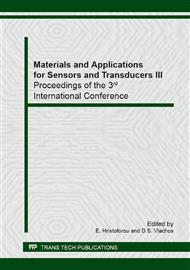p.119
p.123
p.127
p.131
p.135
p.139
p.143
p.147
p.151
New Indigo/Nanocarbons Hybrid Material as Chemical Filter for the Enhancement of Gas Sensor Selectivity towards Nitrogen Dioxide
Abstract:
A new hybrid material performed by the immobilization of indigo particles on nanocarbonaceous matrix has been developed, characterized and implemented with chemoresistors. If phthalocyanine-based chemoresistors provide a high sensitivity, a low threshold of detection and a partial selectivity towards oxidizing pollutants, indigo/nanocarbons hybrid material acts as a selective ozone filter from air sample and so strongly enhances the sensor selectivity towards nitrogen dioxide. The functionalization, highlighted by scanning electron microscopy, X-ray diffraction and thermogravimetric analysis, occurs in a non-covalent way and proceeds through pi-stacking interactions. With filtering yields higher than 99.5% for ozone and less than 5% for nitrogen dioxide, indigo adsorbed onto multi-wall carbon nanotubes has been identified as the most selective filtering material while exhibiting a much greater durability than indigo or nanotubes separately. Associated to phthalocyanine-based gas sensor, the sustainable, selective and real-time monitoring of NO2 in ppb range has been successfully achieved.
Info:
Periodical:
Pages:
135-138
Citation:
Online since:
April 2014
Price:
Сopyright:
© 2014 Trans Tech Publications Ltd. All Rights Reserved
Share:
Citation:


